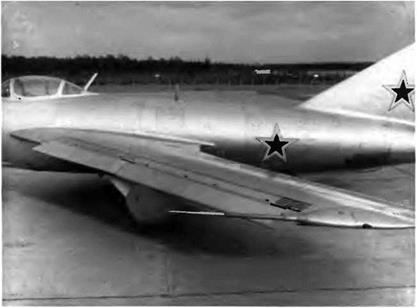MiG 17 / SI-ID
This experimental version was developed to improve the handling of the MiG-17 by modifying its lift devices and adding a variable incidence stabilizer. This effort was made in the context of a plan drawn up by the ministry of aircraft production between 26 and 30 March 1953 to eliminate some of the shortcomings revealed during flight tests. The SI-10 was built with the MiG-17 no. 214 airframe. It differed from the production machine in several ways
—the Fowler-type wing flaps were replaced by split flaps with takeoff and landing deflections of 16 and 25 degrees, respectively
|
Three technical innovations on MiG-17 no 214 automatic slats on the leading edge of the wing, spoilers, and variable incidence stabilizer with elevator |
—67 percent of the wing’s leading edge was taken up by automatic slats (maximum extension angle 12 degrees)
—the standard stabilizer was replaced by a variable incidence stabilizer with elevator (surface deflection -5 to +3 degrees)
—the SI-10 received the first spoilers ever installed on a MiG fighter, with their operation linked to that of the ailerons located on the lower surface of the wing, they extended 55 millimeters (2.16 inches) downward when the aileron displacement was greater than 6 degrees
—the wing fences were removed
The SI-10 was probably the most technically advanced fighter of its time. All of these modifications added weight to the aircraft, however: the new stabilator, 28 kg (62 pounds); spoilers, 14 kg (31 pounds); slats and flaps, 120 kg (265 pounds); and the balance weight, 70 kg (154 pounds).
The aircraft was rolled out at the end of 1954. It was powered by a VK-1A turbojet rated at 2,645 daN (2,700 kg st). Armament consisted of one N-37D and two NR-23 cannons The factory tests took place in early 1955 with G. K. Mosolov, G. A. Sedov, and A. N. Chemoburov at the controls State trials were completed in July Four GK Nil VVS
|
Close-up of the SI-10’s deep-chord leading edge slats |
|
|
The SI-10 wing with lift augmentation at its best: automatic slats at their maximum extension angle of 12 degrees, and split flaps at their maximum deflection of 25 degrees
|
Comparison of the Takeoff and Landing Performance of the SI-10 and SI-02
Source: MiG OKB |
pilots participated in these tests S A. Mikoyan, A. P. Molotkov, V. N. Makhalin, and N. A. Korovin. They made forty-seven flights and spent thirty-two hours and ten minutes in the air. The tests proved that the variable incidence stabilizer and spoilers’ action on the pitch control significantly improved the aircraft’s handling characteristics, especially at high speeds and altitudes. However, the addition of the slats and the modification of the flaps did not seem to have any effect.
Specifications
Span, 9 628 m (31 ft 7 in); length, 11 264 m (36 ft 11.5 in), height, 3.8 m (12 ft 5 6 in); wheel track, 3 849 m (12 ft 7.5 in); wing area, 22,6 m2 (243.3 sq ft); empty weight, 4,140 kg (9,125 lb); takeoff weight, 5,490 kg (12,100 lb); fuel, 1,128 kg (2,486 lb); wing loading, 242.9 kg/m2 (49.8 lb/sq ft).
Performance
Except as noted in the table above, the SI-10’s performance data were almost identical to those of the MiG-17 (SI-02).













